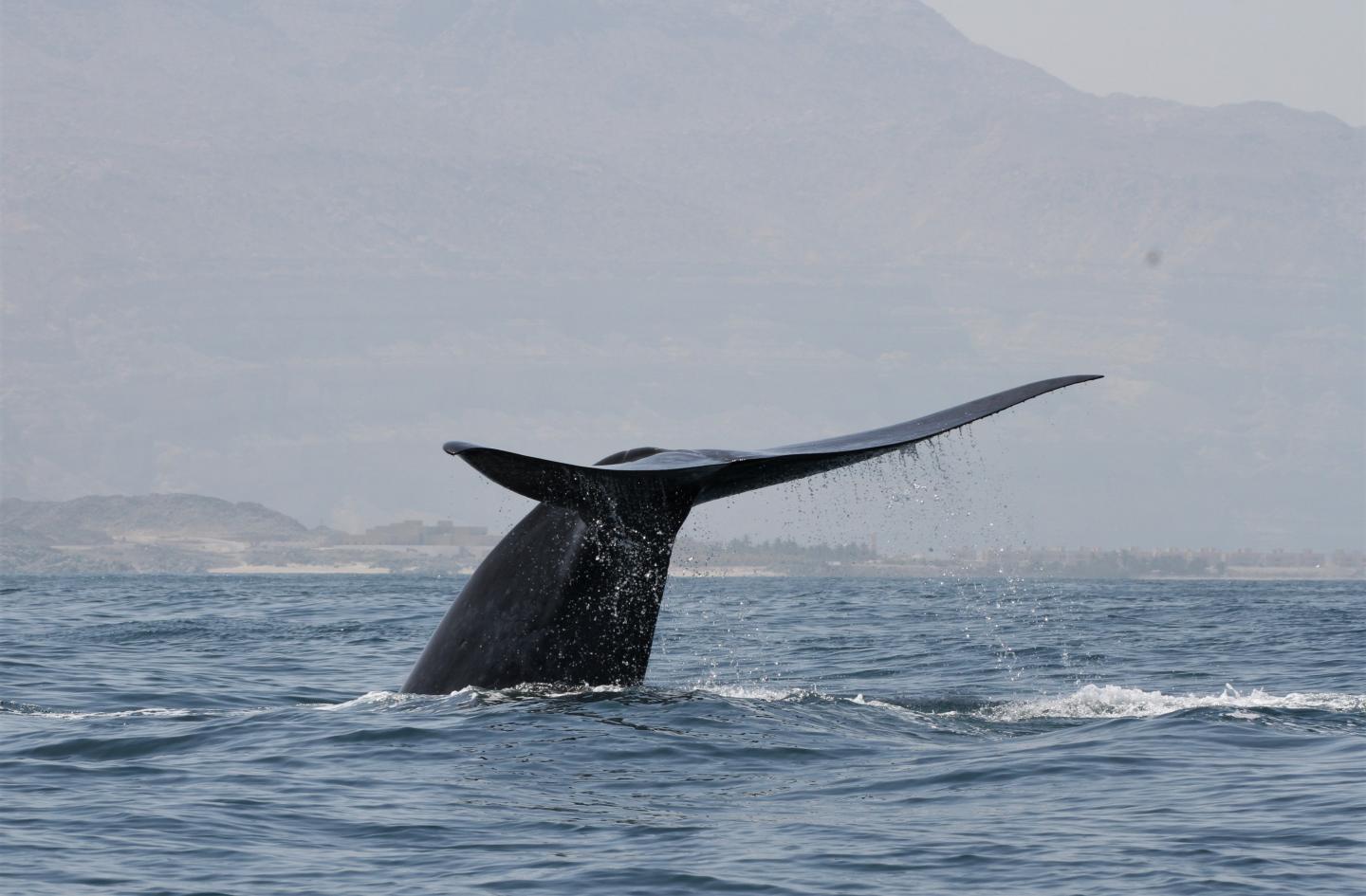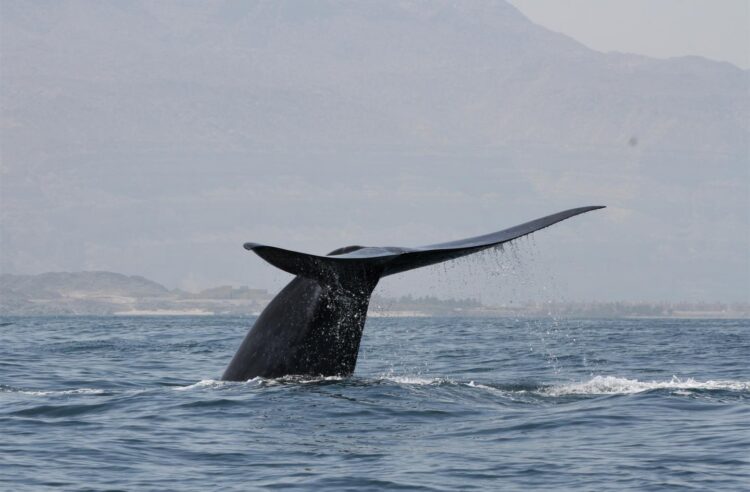
Credit: Robert Baldwin/Environment Society of Oman
An international team of researchers has discovered what it believes to be a new population of blue whales in the western Indian Ocean.
Blue whales are the largest animals that have ever lived on our planet, and they are found around the globe in all oceans. All blue whales sing very low-pitched and recognizable songs, and conveniently for researchers, every population has its own unique song. In a recently published paper in the journal Endangered Species Research, the researchers describe a new blue whale song that is heard from the Arabian Sea coast of Oman across to the Chagos Archipelago in the central Indian Ocean and as far south as Madagascar in the southwest Indian Ocean.
Dr. Salvatore Cerchio, Director of the African Aquatic Conservation Fund’s Cetacean Program and Visiting Scientist at the New England Aquarium, led the analysis of recordings of the whale from three locations in the western Indian Ocean. Dr. Cerchio first recorded the novel song in 2017, during research focused on Omura’s whales in the Mozambique Channel off Madagascar, and he recognized it as a blue whale song that had never been described. Cerchio was also working with a team of scientists collecting acoustic recordings off the coast of Oman in the Arabian Sea. This is part of a research effort focused on the highly endangered Arabian Sea humpback whale, an ongoing collaboration between the Environment Society of Oman, Five Oceans Environmental Services LLC, Oman’s Environment Authority and Oman’s Ministry of Agriculture, Fisheries and Water Resources.
While analyzing the Oman acoustic data, the team recognized the same unusual song. This novel blue whale song was recorded even more prevalently off Oman than Madagascar, and it became clear to the researchers that they had found what was likely a previously unrecognized population of blue whales in the western Indian Ocean.
“It was quite remarkable,” said Cerchio, “to find a whale song in your data that was completely unique, never before reported, and recognize it as a blue whale.” Blue whale song has been extensively studied globally, and several blue whale populations have been identified based on their distinct songs throughout the Indian Ocean.
“With all that work on blue whale songs, to think there was a population out there that no one knew about until 2017, well, it kind of blows your mind,” Cerchio said.
In 2018, the team reported their findings to the Scientific Committee of the International Whaling Commission (IWC), which was in the process of evaluating the status of blue whale populations in the Indian Ocean. The finding created quite a bit of excitement at the meeting, and raised many new questions about blue whale population movements and structure in the Indian Ocean. Emmanuelle Leroy and Tracey Rogers of the University of New South Wales, in Sydney, Australia, were also conducting acoustic research on blue whales in the Indian Ocean. Upon reading the IWC report on the new song, Leroy recognized that they also had recorded the same song off the Chagos Archipelago in the central Indian Ocean.
“Shortly after we made the first report at IWC,” said Cerchio, “I received an email from Emmanuelle saying, ‘Hey Sal, I think we have that Oman song off the Chagos!'”
The collaborative team grew, and analysis of data from all three sites suggested that the population may spend most of its time in the northwestern Indian Ocean, in the Arabian Sea and to the west of the Chagos. It has long been recognized that a unique population of blue whales resides in the Northern Indian Ocean, but it was assumed that whales in the Arabian Sea belonged to the same population that has been studied off Sri Lanka and ranges into the southcentral Indian Ocean. However, the songs tell a different story.
“Before our recording effort off Oman, there were no acoustic data from the Arabian Sea, and so the identity of that population of blue whales was initially just a guess,” said Andrew Willson from Five Oceans Environmental Services LLC, who led the deployment of the recording units. “Our work shows that there is a lot more to learn about these animals, and this is an urgent requirement in light of the wide range of threats to large whales related to expanding maritime industries in the region.”
Blue whales were hunted to near extinction around the globe during the 20th century, and populations have only started to recover very slowly over the past several decades following the global moratorium on commercial whaling. The Arabian Sea was targeted by illegal Soviet whaling in the 1960’s, an activity that nearly eradicated what were already likely to be small populations of humpback whales, blue whales, sperm whales, and Bryde’s whales.
Some researchers consider both the northern Indian Ocean blue whales and Arabian Sea humpback whales to comprise unique subspecies, not simply populations, making them particularly special and important to biodiversity.
“These populations appear to be unique among baleen whales, in the case of the Arabian Sea humpback whales because of their year-round residency in the region without the same long-range migration of other populations,” Willson points out.
“For 20 years we have focused work on the highly endangered Arabian Sea humpback whale, for which we believe only about 100 animals remain off the coast of Oman,” says Suaad Al Harthi, Executive Director of the Environment Society of Oman. “Now, we are just beginning to learn more about another equally special, and likely equally endangered, population of blue whale.”
###
Additional coauthors of the paper include Robert Baldwin of Five Oceans Environmental Services LLC, Danielle Cholewiak of NOAA Fisheries, Tim Collins of the Wildlife Conservation Society, Gianna Minton of Megaptera Marine Conservation, Charles Muirhead of Duke University, Tahina Rasoloarijao of the Institut Halieutique et des Sciences Marines, Madagascar, and Maïa Sarrouf Willson of the Environment Society of Oman.
The work was supported by the International Whaling Commission, Renaissance Services S.A.O.G., Shell Development Oman LLC (SDO), and NOAA Fisheries.
Media Contact
Pam Bechtold Snyder
[email protected]
Original Source
https:/
Related Journal Article
http://dx.





